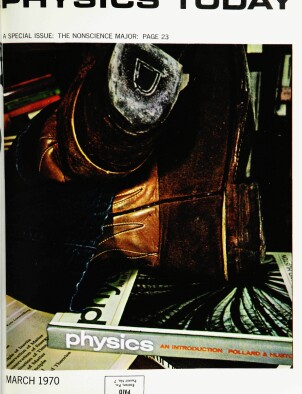What our left hand has been doing
DOI: 10.1063/1.3022016
W
This article is only available in PDF format
References
1. Physics Manpower AIP R 196 (1966).
2. Am. J. Phys. 31, 328 (1963).
3. F. Bitter and others, Am. J. Phys. 28, 568 (1960).
4. W. C. Michels and others, Am. J. Phys. 25, 417 (1957).
5. F. Verbrugge, Am. J. Phys. 31, 293 (1963).
6. E. L. Jossem, Am. J. Phys. 32, 491 (1964).
7. Proceedings of the Boulder Conference on Physics for Nonscience Majors (M. Correll and A. A. Strassenburg, eds.) 1965 (Available from CCP, 4321 Hartwick Road, College Park, Md. 20740).
8. Report of a Conference on Physical Science Courses, Am. J. Phys. 32, 428 (1964).
9. P. Morrison, Am. J. Phys. 32, 441 (1964).
10. P. Morrison, D. Holcomb, My Father’s Watch: Aspects of the Physical World, Prentice‐Hall (preliminary edition).
11. J. M. Fowler, Am. J. Phys. 37, 712 (1969).
12. CCP Newsletter 19 (June 1969).
13. E. A. Wood, CCP Newsletter 17 (October 1968).
14. R. Caplan, Some Notes From Seattle (Available from CCP, 4321 Hartwick Rd., College Park, Md.)
15. CCP Progress Report 1966–68;
E. L. Jossem, Am. J. Phys. 36, 1033 (1968);
CCP Newsletter 11 (October 1966);
CCP Newsletter 12 (February 1967);
CCP Newsletter 15 (March 1968).16. L. Eisenbud, Conceptual Foundation of Quantum Mechanics; G. L. Trigg, Crucial Experiments for Modern Physics (to be published).
17. Symmetry (Contemporary Films Inc., 267 W. 25th St., New York, N.Y. 10001, distributors);
CCP Newsletter 14 (October 1967).18. G. Sehwarz, O. M. Kromhout, S. Edwards, PHYSICS TODAY 22, no. 9, 41 (1969).
19. H. R. Crane, Am. J. Phys. 34, 799 (1966).
20. R. Geballe, R. A. Sawyer, E. L. Jossem, PHYSICS TODAY, 22, no. 11, 120 (1969).
21. CCP Newsletter 18 (December 1968).
22. H. R. Crane, The Physics Teacher 7, 371 (1969).
23. F. Reif, Science 164, 1032 (1969).
24. J. M. Fowler, Am. J. Phys. 37, 1194 (1969).
More about the Authors
John M. Fowler. Commission on College Physics and University of Maryland.
Richard West. Commission on College Physics and University of Maryland.
